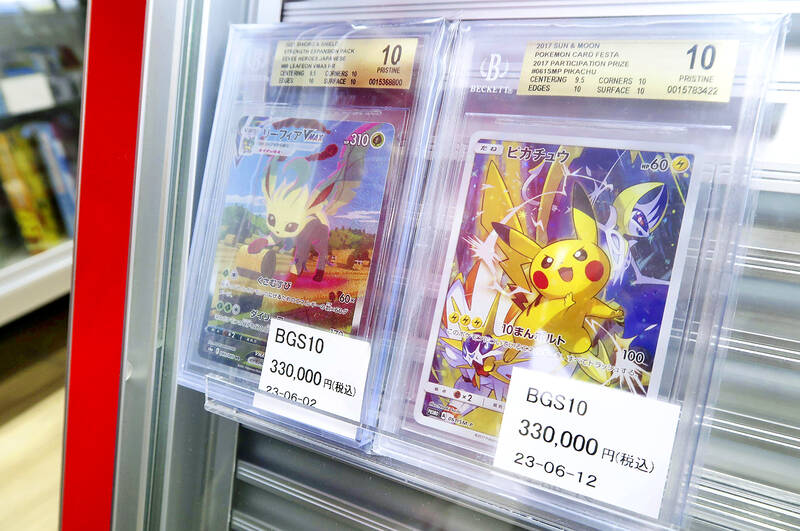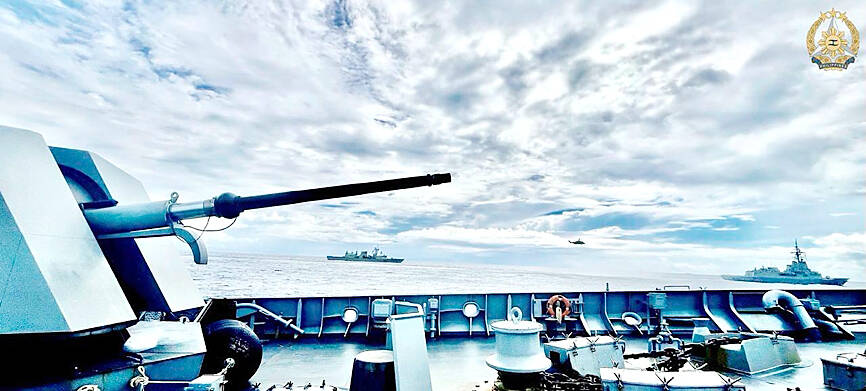A senior member of yakuza was arrested for allegedly stealing Pokemon cards near Tokyo last month, a case seen as an example of Japanese organized crime groups struggling with declining membership.
Police agents who were busy dealing with thousands of yakuza members just a few years ago have noticed something new: unorganized and loosely connected groups they believe are behind a series of crimes once dominated by yakuza.
Police call them “tokuryu,” anonymous gangsters and tech-savvy young people hired for specific jobs. They often cooperate with yakuza, obscuring the boundary between them and making police investigations more difficult, experts and authorities say.

Photo: AP
The Tokyo metropolitan police are investigating six suspects in their 20s and 30s, most of them without connections to one another, who are believed to have been hired on social media to kill, transport and burn the bodies of an older couple at a riverbank of Nasu, 200km northeast of Tokyo.
“It’s a crime carried out like a part-time job,” Taihei Ogawa, a former police investigator and crime analyst, said on an online talk show. “Tasks are divided, making it difficult for police to track down where instructions come from.”
The yakuza membership has shrunk to 20,400 last year, one-third what it was two decades ago, Japanese National Police Agency data showed.
The agency attributed the decline largely to legislation passed to combat organized crime that includes measures such as barring members of designated groups from opening bank accounts, renting apartments, buying cellphones or insurance.
Yakuza once operated from well-marked offices, often with signs out front and symbols of their trade such as lanterns and samurai swords visible through the windows. They were often portrayed in films and cartoons as noble outlaws with a code of honor. Their typical rackets were extortion, gambling, prostitution, gunrunning, drug trafficking and construction kickbacks.
Gang violence in a number of neighborhoods, including the 2007 fatal shooting of then-Nagasaki mayor Iccho Ito during his election campaign, led the government to tighten gun controls, racketeering laws and other anti-gang measures.
Local residents and businesses have also stepped up and filed dozens of lawsuits against yakuza groups to bar them from their communities. In December 2022, Fukuoka city filed for a court injunction to close down an office led by the Kobe Yamaguchi-gumi branch of yakuza near elementary and junior-high schools, and forced it off the street six months later.
The aging of yakuza members and their financial difficulties have also hobbled the syndicate, experts say.
The number of arrested yakuza members last year declined to 9,610, compared with 22,495 in 2014, police said.
Yakuza crackdowns have driven many members to quit and sent others underground, but they also prompted younger generations to join “tokuryu” groups rather than the traditional criminal structures, Noboru Suetomi, a criminologist and expert on yakuza, wrote in a recent article.
The National Police Agency describes “tokuryu” as “anonymous and fluid” groups that repeatedly form and disband through social media to carry out swindling, illegal betting, prostitution and other crimes often remotely, including from overseas.
They recruit participants who are not connected to each other and assign them specific roles. While often cooperating with conventional yakuza, they invest their earnings into illegal businesses, the agency said.
“They have become a threat to public safety,” it said.
While numbers are hard to track, more than 10,000 people were arrested from 2021 to last year for alleged swindling, illegal drug trade and other crimes, such as forgery of identification cards, which were linked to “tokuryu,” records showed.
In April 2022, police busted a ring of 19 people recruited anonymously who operated a fake telecom out of Cambodia and swindled elderly Japanese. Last year, Tokyo police arrested six people who got in touch via social media and carried out a high-profile daytime robbery of watches and jewelry worth ¥300 million (US$1.93 million) at a store in Tokyo’s posh Ginza district.
Japanese National Police Chief Yasuhiro Tsuyuki, at a meeting on Monday of top prefectural criminal investigators, said that “tokuryu” have been part of surging cases of swindling over social media and have become a “serious concern.”

Australia has announced an agreement with the tiny Pacific nation Nauru enabling it to send hundreds of immigrants to the barren island. The deal affects more than 220 immigrants in Australia, including some convicted of serious crimes. Australian Minister of Home Affairs Tony Burke signed the memorandum of understanding on a visit to Nauru, the government said in a statement on Friday. “It contains undertakings for the proper treatment and long-term residence of people who have no legal right to stay in Australia, to be received in Nauru,” it said. “Australia will provide funding to underpin this arrangement and support Nauru’s long-term economic

‘NEO-NAZIS’: A minister described the rally as ‘spreading hate’ and ‘dividing our communities,’ adding that it had been organized and promoted by far-right groups Thousands of Australians joined anti-immigration rallies across the country yesterday that the center-left government condemned, saying they sought to spread hate and were linked to neo-Nazis. “March for Australia” rallies against immigration were held in Sydney, and other state capitals and regional centers, according to the group’s Web site. “Mass migration has torn at the bonds that held our communities together,” the Web site said. The group posted on X on Saturday that the rallies aimed to do “what the mainstream politicians never have the courage to do: demand an end to mass immigration.” The group also said it was concerned about culture,

ANGER: Unrest worsened after a taxi driver was killed by a police vehicle on Thursday, as protesters set alight government buildings across the nation Protests worsened overnight across major cities of Indonesia, far beyond the capital, Jakarta, as demonstrators defied Indonesian President Prabowo Subianto’s call for calm. The most serious unrest was seen in the eastern city of Makassar, while protests also unfolded in Bandung, Surabaya, Solo and Yogyakarta. By yesterday morning, crowds had dispersed in Jakarta. Troops patrolled the streets with tactical vehicles and helped civilians clear trash, although smoke was still rising in various protest sites. Three people died and five were injured in Makassar when protesters set fire to the regional parliament building during a plenary session on Friday evening, according to

STILL AFLOAT: Satellite images show that a Chinese ship damaged in a collision earlier this month was under repair on Hainan, but Beijing has not commented on the incident Australia, Canada and the Philippines on Wednesday deployed three warships and aircraft for drills against simulated aerial threats off a disputed South China Sea shoal where Chinese forces have used risky maneuvers to try to drive away Manila’s aircraft and ships. The Philippine military said the naval drills east of Scarborough Shoal (Huangyan Island, 黃岩島) were concluded safely, and it did not mention any encounter with China’s coast guard, navy or suspected militia ships, which have been closely guarding the uninhabited fishing atoll off northwestern Philippines for years. Chinese officials did not immediately issue any comment on the naval drills, but they